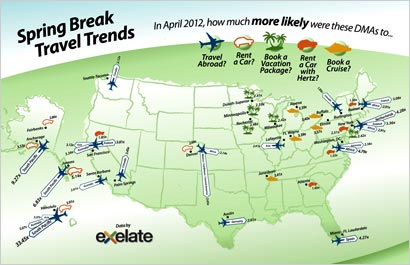
Data company eXelate has begun to offer clients aggregate historic data across industries to identify trends in travel, retail, finance
and other industries, building out spreadsheets and infographs to provide visual support for geographic online ad targeting.
eXelate aggregates search term query data and runs it through the
maX index, part of the maX data platform. It adds a layer of data to what the company calls its "syndicated and premium" offering. The data in the infograph collected in April comes from about 200
million unique user IDs in the U.S. and hundreds of billions of transactions.
Combined, the information aims to provide better targeting decisions by integrating billions of third-party online
and offline data points. While the data used to create the infographic came from "other data publishers and partners," eXelate does work with Nielsen, Nielsen Catalina Solutions, MasterCard, and
dozens of other companies to custom build adaptive data sets.
Travel trends by designated market area (DMA) for April analyze in aggregate on-site searches and clicks from
"a large number" of Web sites. Miami, Ft. Lauderdale, for example, suggests people within the DMA are 4.27-times more interested in traveling to Spain as compared with people in the rest of the
country. In Manhattan, compared with elsewhere in the United States, people are more interested in traveling to the Netherlands (4.28), France (3.36) and Africa (2.91), as well as booking a car (2.52)
with Hertz, or a vacation package (4.42).
eXelate can model the tool to create forecasts, as well as analyze historic trends, although the data isn't available today, according to Kevin Lyons,
eXelate analyst. "We would need to build out the system," he said. "We have clients taking the raw data that is trying to predict trends, but we don't do that today."
The
geographic data collected from the Internet service provider matches to a DMA, explains Lyons. The technology can locate the computer accessing the Internet within about 25 miles in roughly 90% to 95%
accuracy. It's also technically possible to integrate search engine data, but that is not being done today.
Lyons said this is one example of how companies can use the suite of products and
index to gain insights for geographic targeting.